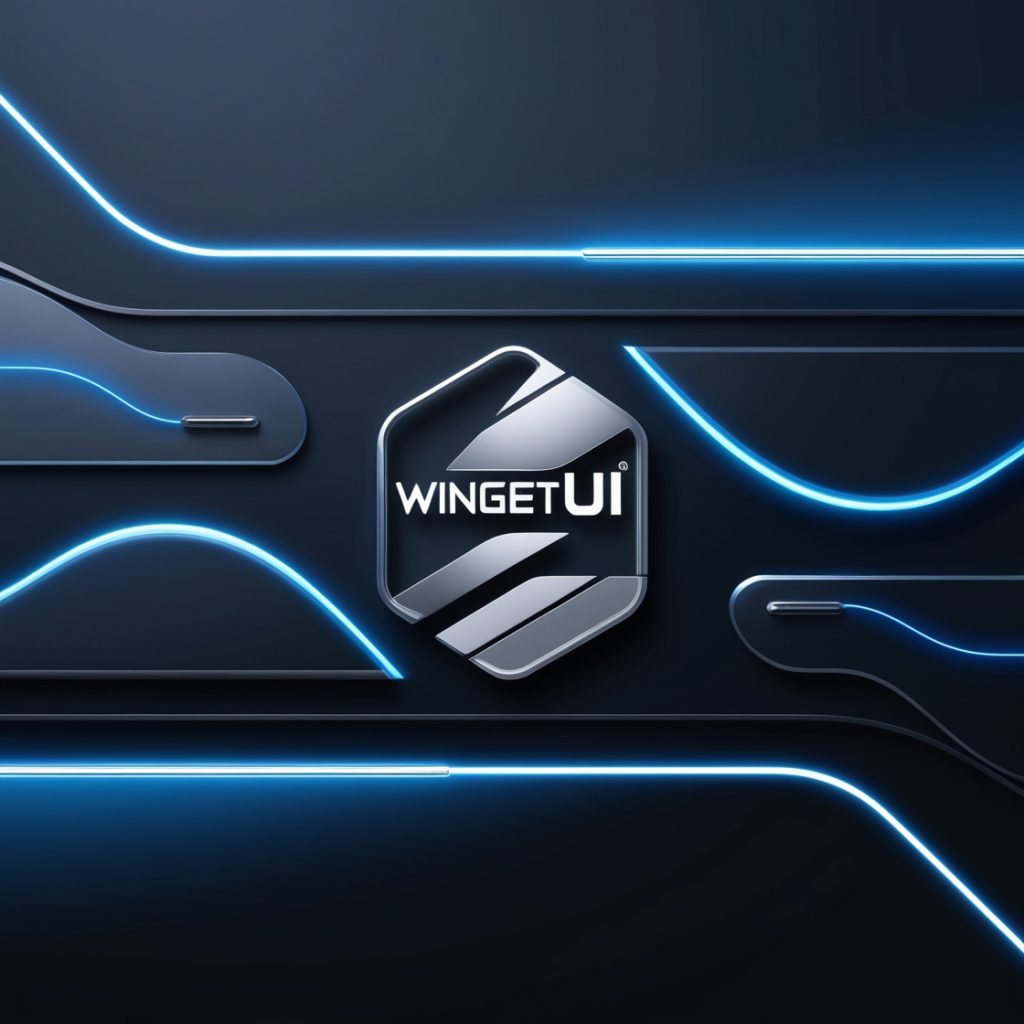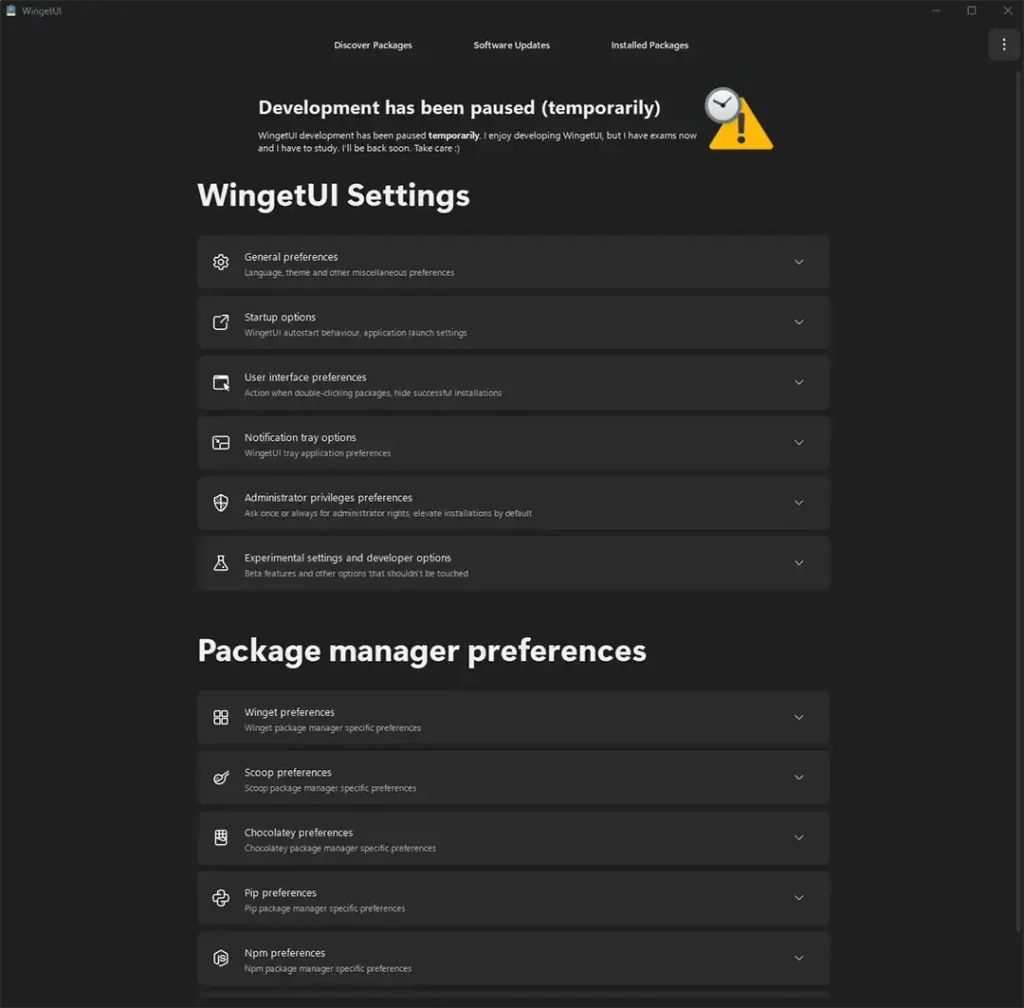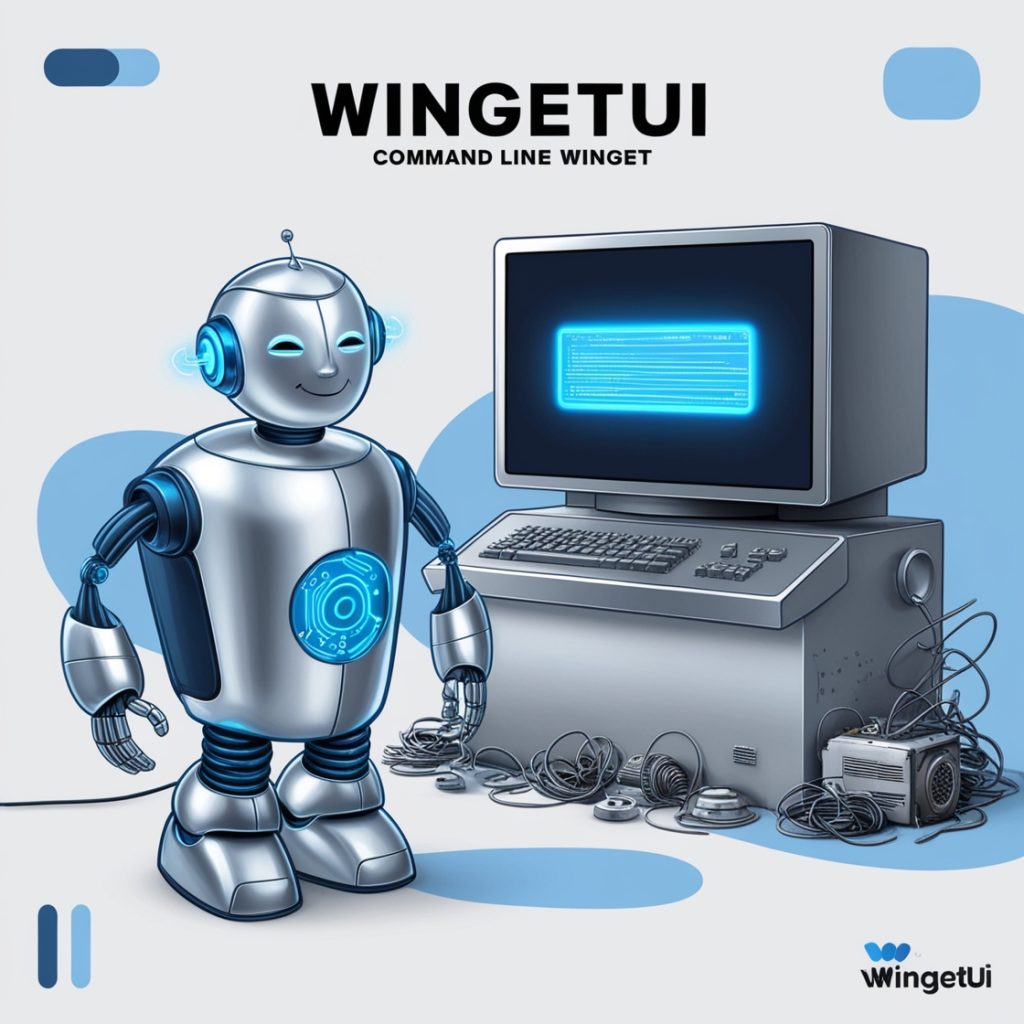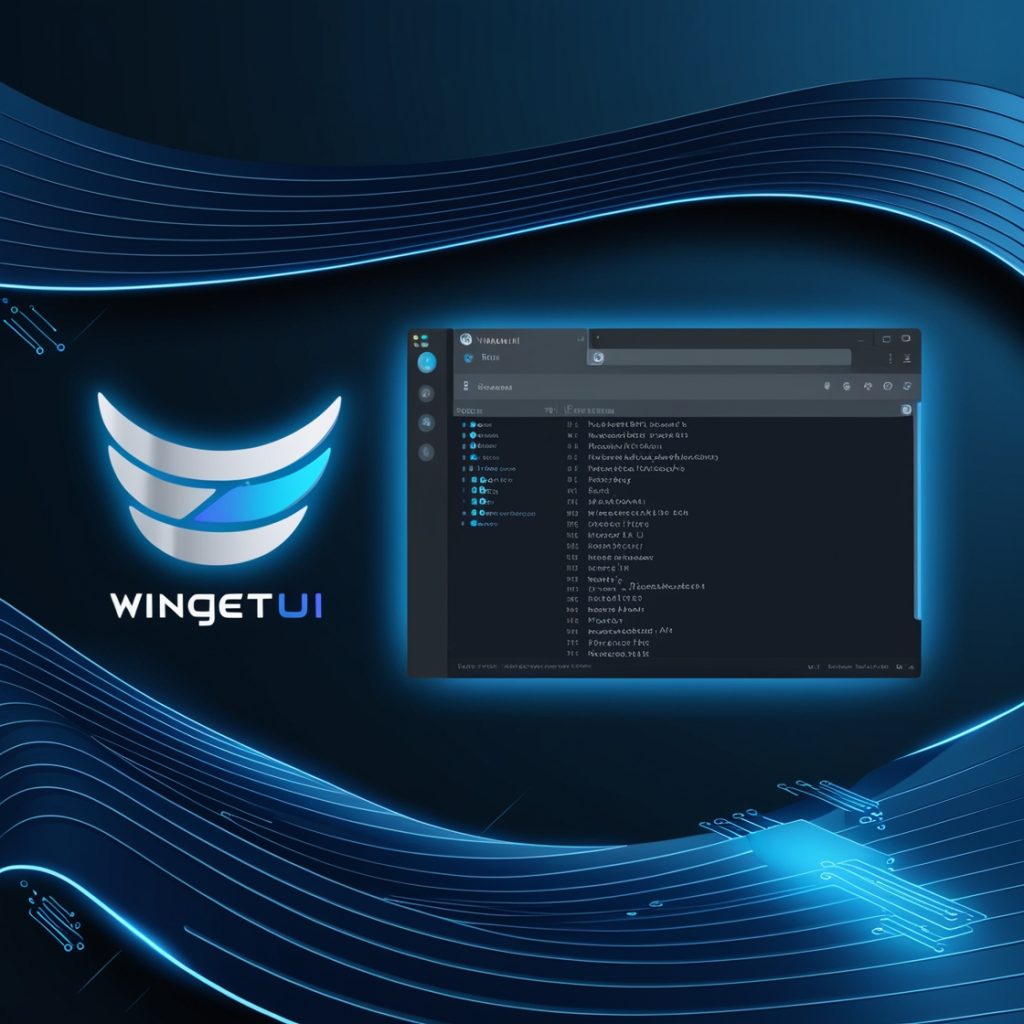WingetUI - Easy Windows Package Management Software
WingetUI is a powerful and user-friendly graphical interface for Windows Package Manager (winget). Designed to simplify software installation, management, and updates, WingetUI allows users to easily browse, install, and uninstall applications with just a few clicks. Whether you’re a tech enthusiast or a casual user, WingetUI makes managing your software library a breeze.

Winget, short for Windows Package Manager, is a command-line tool developed by Microsoft to streamline software management on Windows systems. With Winget, users can install, update, and uninstall software directly from the command line. While it is highly efficient, allowing users to manage multiple applications with simple commands, the reliance on a command-line interface (CLI) can be intimidating for casual or non-technical users.
Key Features of WingetUI

Multiple Package Support
WingetUI supports Winget, Scoop, and Chocolatey, offering users access to a wide range of software packages.

Extensive Software Catalog
WingetUI provides access to over 10,000 software packages across its supported package managers.

User-Friendly Interface
WingetUI features a modern, intuitive interface, making it easy for users to navigate and manage software.
Getting Started with WingetUI
Installation Guide
- Visit the Official Website:
Go to the WingetUI GitHub page or the official website where the application is hosted. - Download the Installer:
Locate the latest release of WingetUI. Click on the download link for the installer (usually a .exe or .msi file). - Run the Installer:
Once the download is complete, navigate to your downloads folder and double-click the installer file to start the installation process. - Follow the Installation Wizard:
The installation wizard will guide you through the process. Accept the license agreement and choose the installation location (you can use the default path). - Complete the Installation:
Click “Install” to begin the installation. Once it’s finished, you’ll see a completion message. Click “Finish” to exit the wizard. - Launch WingetUI:
After installation, you can find WingetUI in your Start menu. Click to launch the application.

Initial Setup
- Launch the Application:
On your first run of WingetUI, a setup window will appear. - Select Package Managers:
You will see checkboxes for the supported package managers: Winget, Scoop, and Chocolatey.
By default, Winget and Chocolatey will be selected. You can also check the box for Scoop if you wish to use it. - Confirm Your Selection:
After making your selections, click “Next” or “Finish” to save your preferences. - Access the Main Interface:
Once the initial setup is complete, you will be taken to the main interface of WingetUI, where you can start browsing and managing software.
This straightforward installation and setup process makes it easy for users to get started with WingetUI, allowing them to efficiently manage their software with minimal hassle.
Navigating the Software Catalog
How to Browse and Search for Software
Navigating the software catalog in WingetUI is designed to be intuitive and straightforward. Here’s how you can effectively browse and search for software:
- Accessing the Catalog:
Once you open WingetUI, you’ll be presented with the software catalog interface. This area displays a grid or list of available applications organized by categories or popularity. - Browsing Categories:
You can browse through different categories such as productivity, utilities, games, and more. Clicking on a category will filter the displayed applications, making it easier to find software tailored to your needs. - Using the Search Bar:
At the top of the catalog, you’ll find a search bar. Enter the name of the application or keywords related to what you’re looking for. As you type, WingetUI will dynamically filter results, allowing you to quickly find relevant software.

- Sorting Options:
Many versions of WingetUI provide sorting options (e.g., by name, popularity, or date added). Utilizing these sorting features can help you discover new or trending applications.
Tips for Finding Popular and Useful Applications - Check User Ratings and Reviews:
If available, user ratings and reviews can give you insight into the quality and performance of an application. Look for software with high ratings and positive feedback. - Look for Featured or Recommended Apps:
WingetUI often highlights featured or recommended applications. These selections are typically curated based on popularity or user feedback, making them a good starting point. - Explore Top Downloads:
If the catalog includes a section for top downloads, check this regularly. Popular software tends to be widely used and trusted by the community. - Utilize Community Forums or Resources:
Online forums, social media groups, or tech blogs can provide recommendations for useful applications. Engaging with these communities can help you discover hidden gems or new tools. - Stay Updated with New Releases:
Regularly revisit the software catalog to see new releases and updates. Software developers frequently introduce new features and enhancements that could be beneficial.
By following these steps and tips, you can efficiently navigate the software catalog in WingetUI and discover applications that meet your needs, enhancing your overall software management experience.
Advantages of WingetUI Over Command Line Winget

User-friendly Graphical Interface
WingetUI provides a graphical user interface (GUI) that simplifies software management on Windows, especially for users who are not familiar with command-line operations. Unlike the standard Windows Package Manager (Winget), which requires users to type and memorize commands, WingetUI allows users to visually interact with their system.
This intuitive interface helps users browse, install, and update software with just a few clicks, eliminating the need for complex command-line syntax. The GUI displays packages, their details, and available updates in an easy-to-understand format, making it accessible for both beginners and experienced users.
Faster Package Management for Non-technical Users:
For users unfamiliar with command-line tools, Winget can seem daunting. With WingetUI, users can manage packages more quickly without needing to learn terminal commands or syntax. This speeds up the process of software management, reducing the likelihood of mistakes that can occur in the command line.
The graphical interface allows users to view all available software, search for packages, and apply updates or installations faster. This is particularly helpful for users who prefer a more visual approach rather than typing each command manually.
Bulk Operations Made Simple
WingetUI shines when it comes to bulk operations. In the command line, installing or updating multiple packages requires multiple commands, each executed one at a time. With WingetUI, users can select multiple programs simultaneously and install or update them all at once.
Bulk installation and update features are highly efficient for users who manage several pieces of software regularly. This reduces the need for repetitive tasks, saving time and ensuring that all necessary updates are completed in one go.
WingetUI offers significant advantages over the command-line version of Winget by providing a user-friendly, efficient, and simplified approach to managing software on Windows, making it accessible for non-technical users and those who prefer faster, bulk operations.
Supported Package Types in WingetUI
WingetUI is a graphical user interface (GUI) for the Windows Package Manager (winget) that allows users to easily install, update, and manage software packages on their Windows devices. One of the key advantages of WingetUI is its ability to handle a variety of package types, making it versatile and efficient for managing different types of software. Below is an explanation of the types of packages supported by WingetUI:
Windows Apps (UWP, EXE, MSI)
- UWP (Universal Windows Platform): UWP apps are applications specifically designed for the Windows ecosystem, often downloaded through the Microsoft Store. WingetUI simplifies the process of installing, updating, and managing UWP apps by offering a user-friendly interface, eliminating the need to manually interact with the store.
- EXE (Executable Files): EXE files are the most common format for installing Windows desktop applications. With WingetUI, you can easily install EXE-based software packages directly from the interface, making it easy to manage large lists of software that require EXE installers.
- MSI (Microsoft Installer): MSI is another installer format used for installing, maintaining, and removing software on Windows systems. WingetUI supports MSI packages, allowing users to seamlessly handle installations and updates for software that use this format.
Open-source and Third-party Apps
- WingetUI provides extensive support for open-source applications, allowing users to access a wide variety of free and community-driven software solutions. This includes popular tools and utilities like VLC, 7-Zip, GIMP, and more, which are often developed and maintained by the open-source community.
- Third-party apps refer to software not officially distributed by Microsoft but made available through various repositories or the web. WingetUI makes it easier to install third-party software by offering pre-configured package repositories or allowing users to add their own repositories. This extends the functionality of WingetUI beyond typical Windows apps, supporting a broader range of tools and utilities from various developers.
Other Software Repositories Supported by WingetUI
- WingetUI supports integrating additional software repositories beyond the standard Windows Package Manager source. Users can add custom repositories, which may contain software packages that are not available in the default winget repository.
- This feature allows users to expand the scope of available packages, accessing proprietary or niche software from trusted sources. The ability to work with multiple repositories increases flexibility, making it easier to find and manage software that suits specific needs.
WingetUI supports a wide range of software package types, including native Windows apps (UWP, EXE, MSI), open-source tools, and third-party applications. Its capability to integrate with additional software repositories makes it a powerful tool for managing software on Windows, offering flexibility and convenience for both novice and advanced users.
WingetUI for Developers
WingetUI is not just a tool for regular users to manage software; it also offers significant value for developers. Developers can leverage WingetUI’s graphical interface to simplify software deployment, manage development environments, and even contribute to the package management ecosystem. Below are key ways developers can use WingetUI in their workflows:
Customizing Package Scripts
WingetUI allows developers to create and customize package scripts that automate software installations, updates, and configurations. This feature is particularly useful for streamlining workflows and ensuring that development environments are set up consistently across different machines.
- Script Automation: Developers can write scripts that automate package installations, specifying dependencies, versions, and configurations required for their projects.
- Batch Installations: With WingetUI’s graphical interface, developers can select multiple packages for batch installation, significantly reducing the time it takes to set up a development environment.
- Scripting Flexibility: Custom scripts can be tailored to install different software combinations based on project requirements. For example, a developer can create scripts for installing specific versions of programming languages, IDEs, compilers, and libraries in a single operation.

- Version Control: Developers can maintain different package versions for different projects. Custom scripts can enforce the installation of specific versions of tools and dependencies, which ensures compatibility between development environments and production deployments.

Creating and Maintaining Package Repositories
WingetUI integrates seamlessly with the Windows Package Manager (winget), which uses a central repository for managing available software packages. However, developers can create and maintain their own repositories to control software distribution within their teams or organizations.
- Private Repositories: Developers can create private repositories to host proprietary or internal software packages. This is especially useful for managing in-house tools and ensuring team members have the latest versions.
- Contributing to Public Repositories: WingetUI is compatible with the public Windows Package Manager repository. Developers can contribute new packages or maintain existing ones by adding new versions, fixing bugs, or improving package definitions. This helps other developers and users access up-to-date software.
- Custom Repository Hosting: Developers can also host custom repositories on private servers or platforms like GitHub. This allows the flexibility to manage software outside the main Windows package ecosystem, making it ideal for development teams that need customized environments.
- Repository Maintenance: WingetUI allows developers to manage repository dependencies, ensuring that all software versions are compatible and that conflicts are resolved before deployment. It also supports automated repository syncing, ensuring that repositories stay updated without manual intervention.
General Questions (FAQ's)
WingetUI provides a graphical interface, making it easier to install, update, and uninstall software without using the command line.
Yes, WingetUI is open-source and completely free to use.
You can download WingetUI from its official GitHub repository or other trusted sources like the Microsoft Store.
Yes, WingetUI is open-source and does not contain any harmful software. It uses the same trusted repositories as the Windows Package Manager.
WingetUI primarily supports English, but additional language support may be available based on the version.
You can search for the software in the WingetUI interface and click “Install” to begin the installation process.
Yes, WingetUI supports batch updating of multiple programs simultaneously.
Yes, you can uninstall any installed programs directly from WingetUI.
Yes, WingetUI supports both Microsoft Store apps and third-party apps available through the Windows Package Manager repository.
Yes, you can choose specific versions of software if they are available in the repository.
Yes, WingetUI manages dependencies automatically, installing any required software during package installation.
Yes, WingetUI allows you to install multiple software packages in bulk.
Yes, WingetUI includes a powerful search feature that lets you find software by name, category, or version.
ReiBoot supports iPhone, iPad, iPod Touch, Mac, and Apple TV.
Yes, you can add custom repositories to manage and install packages that are not available in the default Windows Package Manager repository.
WingetUI checks for updates for installed programs and lets you update them through its graphical interface.
Check your internet connection, ensure you have sufficient permissions, and try running the installation again. If the problem persists, check for specific error messages or logs.
WingetUI only detects software that was installed via winget or available in the repository. Manually installed or non-winget software may not be listed.
Ensure that the Windows Package Manager (winget) is installed and updated. You can also try reinstalling WingetUI.
The software may not be available in the default repository. You can try adding a custom repository or check for package updates.
Ensure that you are installing compatible versions of software, especially when dealing with dependencies. You may need to resolve conflicts manually by uninstalling specific versions.
WingetUI does not have a built-in reset feature, but you can manually delete its configuration files or reinstall the app to reset it.
This may happen if you have a large number of installed programs or if the repository is slow. Ensure your system meets the minimum requirements and try refreshing the repository list.
Yes, developers can contribute to WingetUI on its GitHub page by submitting bug reports, feature requests, or code contributions.
Yes, developers can write custom package scripts that automate software installation and update processes, using both the command line and WingetUI’s graphical interface.
WingetUI works with Windows 10 and Windows 11.
WingetUI - Free Download V3.1.1 for Windows

WingetUI, a user-friendly GUI for Windows Package Manager, simplifying software installation and management. Download the latest version now! #WingetUI
Price: Free
Price Currency: $
Operating System: Windows 7, 8, 8.1, 10, or 11
Application Category: Softwate
4.3